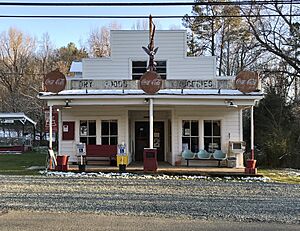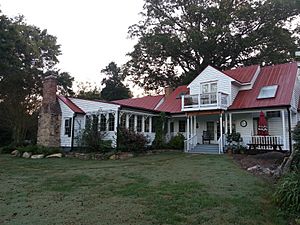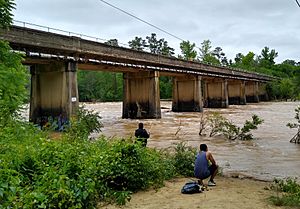Bynum, North Carolina facts for kids
Quick facts for kids
Bynum, North Carolina
|
|
|---|---|

Bynum General Store
|
|
| Country | United States |
| State | North Carolina |
| County | Chatham |
| Elevation | 341 ft (104 m) |
| Time zone | UTC-5 (Eastern (EST)) |
| • Summer (DST) | UTC-4 (EST) |
Bynum is a small place in northeastern Chatham County, North Carolina, United States. It's called an "unincorporated community," which means it doesn't have its own local government like a city or town. Bynum is located right next to the Haw River.
This community is about 5 miles north of Pittsboro and 11 miles south of Chapel Hill. People also know Bynum as Bynum Mill Village or Bynum Mill Hill because of its history with a cotton mill.
The most famous building in Bynum is the Bynum General Store. For many years, Frank and Louise Harris ran it as Harris and Farrell General Store. It was a central spot where people picked up their mail and shared local news. Today, the store is a community center run by a group called Bynum Front Porch. They host a popular music series there every Friday evening from May to September. Famous singer Tift Merritt even started her music career playing on the store's front porch!
Contents
Exploring Bynum's Past: A Mill Town Story
Bynum started as a "cotton mill town." This means a mill was the main reason the community grew. The first mill was built around 1872 next to the Haw River. A wooden dam upstream helped power the mill's water wheels. Later, a concrete dam was built, and it generated electricity. John Milton Odell bought the spinning mill in 1886.
Life in the Mill Village
Between 1890 and 1910, small houses were built on the hill above the mill. These houses had two to six rooms and were rented to the mill workers and their families. Bynum was one of the first places in Chatham County to have electric lights. This was because the mill's turbines provided electricity for both the factory and the homes. Mill workers were often paid in "scrip," which was like special money. This scrip could only be used to pay rent or buy things at the "company store," which the mill also owned.
Changes for Mill Workers
In the 1970s, the county bought the 73 mill worker houses from the J.M. Odell Manufacturing Company. They used a special grant to do this. With this money, the streets were paved, and the houses were improved with new electrical systems and indoor plumbing. The people living in these homes had been paying very low rent to the mill. They were given the chance to buy their homes with easy, long-term payment plans. Many mill workers had lived in these houses their whole lives, and most of them chose to buy their homes.
Other houses were bought by new people moving into Bynum. Many of these new owners were younger, college-educated people, including musicians, artists, and craftspeople.
The Mill's End and New Beginnings
The Odell Manufacturing mill in Bynum closed in December 1983. The buildings were sold but eventually sat empty and fell apart. Sadly, the mill buildings burned down in March 2001. Most of the original mill houses are still standing today and are now private homes.
The area where the mill once stood is now part of the Lower Haw River State Natural Area. You can find a place to launch canoes, a walking trail, and a parking lot there. A 2-mile trail follows the Haw River southeast to Pokeberry Creek. There are plans to add signs that tell the story of the mill and the village. The old turbine building is still standing, and the mill race (the channel that carried water to the mill) still empties into the Haw River. This natural area is managed by the Jordan Lake State Recreation Area.
The Historic Bynum Bridge
The bridge that crosses the Haw River at Bynum has a long history. It was first a covered wooden bridge. This bridge was an important connection for travel between Chapel Hill to the north and Pittsboro and Sanford to the south. The current concrete bridge, built in 1922, is about 800 feet long.
The bridge was closed to cars in 1999. Today, it's a pedestrian bridge, meaning only people walking or biking can use it. It's also part of North Carolina's statewide bicycle route. The Bynum Bridge is a special gathering place for the community, especially on Halloween. Many local people carve amazing Jack-o'-lanterns and display them all along the sides of the bridge, creating a beautiful and spooky sight. Cars now cross the Haw River on newer bridges about 1000 feet north.
Fun Things to Do in Bynum
Bynum is known for its lively arts and culture scene.
- Halloween on the Bridge: Every Halloween night, hundreds of Jack-o'-lanterns light up the old bridge. Local artists and musicians perform, and there are often haunted houses and trick-or-treating events at the Bynum Methodist Church and Ruritan Club nearby.
- Community Garden: The Bynum Community Garden is a place where people can grow their own plants and vegetables together.
- Earl Thompson Park: This park has a playground for kids and a baseball field, perfect for outdoor fun.
Two historic homes in Bynum, the Robert Joseph Moore House and the Dr. E. H. Ward Farm, are listed on the National Register of Historic Places. This means they are important places that are protected for their historical value.
Famous People from Bynum
- Bill Bynum: A well-known banker and generous giver (philanthropist) who grew up in Bynum.
Images for kids







